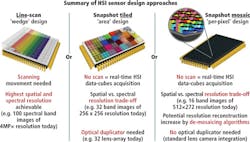Image Capture: CMOS cameras employ hyperspectral sensors
In many industrial, surveillance and medical vision applications, it is necessary to evaluate the spectral signature of materials so that they can be properly identified. Since each material being scanned possesses a unique spectral signature, hyperspectral machine vision systems can be employed to evaluate and sort different types of products. By collecting multiple images, each of a narrow wavelength band, a hyperspectral data cube can then be formed consisting of multiple images, each captured at a narrow wavelength.
In the past, designers of such hyperspectral systems used dispersive light elements such as gratings and prisms to generate these hyperspectral images. Four years ago, however, engineers at IMEC (Leuven, Belgium;www.imec.be) developed a method of producing a hyperspectral imager by integrating novel optics onto a standard CMOS imager (see "Novel technology lowers the cost of hyperspectral imaging," Vision Systems Design, January 2011; http://bit.ly/1tGOUes).
In the first incarnation of the imager, a wedge of Fabry-Pérot filters is placed onto the imager so each filter will transmit a narrow band of wavelengths and reject wavelengths outside of that band. This filter can then be integrated onto a standard CMOS imager to produce a hyperspectral imager.
At last year's VISION show, held in Stuttgart in November, IMEC demonstrated a hyperspectral sensor based on the CMV 2000, a 2048 x 1088 pixel pipelined global shutter CMOS image sensor from CMOSIS (Antwerp, Belgium;www.cmosis.com). By integrating the filter wedge onto the imager, IMEC has realized a hyperspectral imager consisting of 100 spectral bands in 5nm incremental steps over a 470-900nm wavelength range that is capable of a full sensor frame speed of 340 fps.
"Since the imager obtains different spectral signatures across 100 rows of the imager," says Maarten Willems, Business Director at IMEC, "motion of either the sensor or objet being scanned must be performed to capture multi-spectral imagers."
While the line-scan wedge imager was the first multispectral design produced at IMEC, the company has recently announced two more designs that allow area array images to be captured at 340 fps. In the first design, the 2048 x 1088 CMOSIS CMV 2000 image sensor is overlayed with an array of 8 x 4 image tiles each consisting of 256 x 256 pixels.
In this design, the 32 spectral bands are separated at 12nm incremental steps over a 600-1000nm wavelength. To capture images from cameras equipped with the sensor, an optical duplicator is used to replicate the complete field of view of each scene onto each of the 32 image tiles. In this way, cameras equipped with the imager can capture images with a 256 x 256 spatial resolution in 32 spectral bands.
To increase the spectral resolution while trading off the number of spectral bands that can be obtained and eliminating the need for an optical duplicator, IMEC has also developed a mosaic image filter. In this design, a 4 x 4 mosaic consisting of 16 spectral bands separated at 11nm steps over a 465-630nm is used. Standard lenses can then be used to capture images with a spatial resolution of 512 x 272. Here, a demosaicing algorithm can be used to calculate the value of each spectral wavelength at every pixel.
Because each IMEC design is based on the CMOSIS CMV 2000 sensor, camera vendors currently using the sensor can rapidly introduce multi-spectral cameras by replacing the original CMV 2000 imager with pin-compatible multispectral devices.
At the VISION show, a number of third-party cameras were shown booth that used IMEC's multispectral imagers. These included the xiQ USB camera from Ximea (www.ximea.com), the Quartz Camera Link camera from Adimec (Eindhoven, The Netherlands; www.adimec.com), the S200 HYP smart camera from Tattile (Brescia, Italy; www.tattile.com), the Intelligent D3 camera platform from VR Magic (Mannheim, Germany; www.vrmagic.com) and a series of line-scan, tiled and mosaic cameras from 3D-One (Leiden, The Netherlands; http://3d-one.com).

